 |
|||||
Featured Artists
Current Exhibition
Reception
See Also
Contact Us
Blogs |
Dear Art Enthusiast, 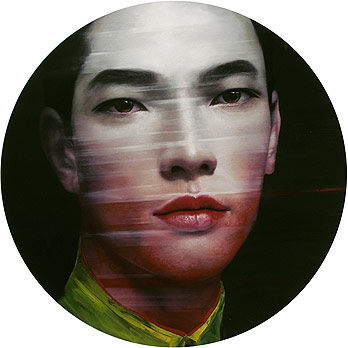
Ling Jian, Hero 2, Archival Inkjet Print, 2010, 35-inch diameter, Ed 35 ArtSpace/Virginia Miller Galleries Showcasing Contemporary Chinese ArtistsDuring the Maoist era in China, spanning a generation from 1949 to 1976, the only accessible "art" was propaganda promoting the government and its policies. These were the images that Wang Guangyi, born in 1957, grew up with.When the Cultural Revolution ended and China's economy shifted into the global marketplace, advertising for luxury brands demanded by the country's burgeoning newly affluent began to spread. Consolidating the two preponderant visual influences during his lifetime, in the 1990s Wang began producing his "Great Criticism" series. These use images from the propaganda posters contrasted with international brand names, such as BMW or Rolex, often with the enigmatic word "No" added. 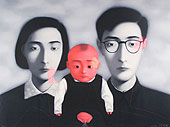
Zhang Xiaogang, Bloodline: Big Family, 2006, Lithograph, 49 x 57 inches Although critics are uncertain about its artistic intent, the "No" and implicit tension between Maoist and consumer imagery suggest the conflict between an idealized proletariat and Western luxury products.For the international art market, Wang's concept apparently expresses the state of an evolving China: one of his larger "political pop" paintings sold for $4.1 million at a Phillips de Pury & Company auction in London. Three of Wang's serigraphs are included in "Portal: Contemporary Chinese Paintings, Prints, Photos, and Sculpture." Just as his works combine Cultural Revolution images with present-day Western luxury-items advertising, most of the other artists included in the show link contemporary techniques or images to their country's artistic traditions. 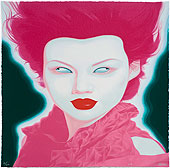
Feng Zhengjie, Chinese Portrait Series No.38, 2008, Silkscreen, 32 x 32 inches Another leading Chinese artist, Zhang Xiaogang, uses their tradition of formally posed family photographs for his "Big Family" series. For Zhang, "family" implies the wider community of Chinese collectivism, with some of his subjects individualized by birthmarks or other small differences.Feng Zhengjie is represented by three serigraphs of his "Chinese Portrait Series," stylized head-and-shoulder depictions of wild-eyed contemporary women, usually done in such traditionally symbolic colors as red and green. Sometimes viewed as critical of China's ravenous appetite for luxury goods, Zhengjie feels "the influence of the Western culture makes our women appear as hybrids sometimes." The multimedia artist Huang Yan superimposes traditional Chinese landscape scenes upon photos of faces and the human body. His fusion of ancient art forms with contemporary views of the body creates a new concept that every Chinese can relate to. 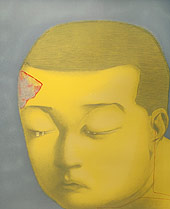
Zhang Xiaogang, Fantasy, Lithograph, 2002, 25 1/4 x 21 inches, Ed. 199 Sui Jianguo, referred to as "a leading figure of China's New Sculpture movement" in the "China Onward" catalog of the renowned Estella Collection, draws attention "to the political and economic system behind the toy industry" through his "Made in China" series and toy dinosaurs. He views his dinosaurs as parallels to much of the world's manufacturing: designed in the West, made in China, and then exported globally—not unlike Chinese contemporary art, inspired by Western traditions.Works by Zhang, Feng and Yan are in the Sigg Collection, widely considered the world's largest and most comprehensive collection of contemporary Chinese art. All three artists were included in "Mahjong," an important exhibition held in 2009 at the University of California's Berkeley Art Museum, as well as the current "101 Artworks—A Stroll through the Sigg Collection" at 88MOCCA, the Museum of Chinese Contemporary Art on the Web. Both shows were compiled from SIGG Collection artworks. 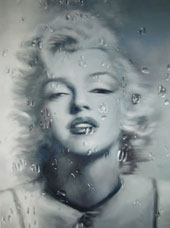
Yang Qian, Untitled (Water Drops), Archival Inkjet Print with Silkscreen, Ed. 200, 32 x 40 inches, 2009 Along with sculpture by Sui, artworks by Feng, Guo, Huang, and Zhang also are represented in the Estella Collection of Chinese Contemporary Art, first exhibited at the Louisiana Museum of Modern Art in Humlebæk, Denmark in 2007.The works by Yang Qian are from his "Bathroom" series, images viewed through a mist of water drops, suggesting the overlapping of reality and illusion, sometimes categorized as "dual paintings." Works by Guo Wei focus on everyday life, often with relationships between adolescents, emphasizing the development of individualism in China since the homogenization of the Cultural Revolution. 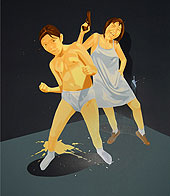
Guo Wei, Tireur de Pistolet No. 4, Silkscreen, 35 x 40.5 inches, 2009 Leading print and online publications, such as "The Economist," "The London Times," and Artprice.com have reported the soaring prices of contemporary Chinese art. Although virtually all art prices recently dropped somewhat as the worldwide economy sagged, the media have reported that contemporary Chinese art prices are leading their resurgence."Some of the artists in this show are stellar," said gallery owner and curator Virginia Miller. "For example, in October 2010 one of Zhang Xiaogang's paintings sold for $4.6 million at Sotheby's Hong Kong." 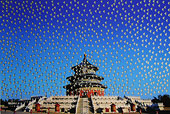
Huang Yan, Temple of Heaven, Archival Inkjet Print with Silkscreen, Ed. 200, 34 ½ x 47 inches, 2008 "This will be our fourth exhibition of contemporary Chinese art," Miller noted. "These works offer an exceptional opportunity to acquire original works by some of China's leading artists."Included in "Portal" will be paintings by artists who were represented in earlier Chinese shows at the gallery, including Wang Niandong and Cao Xiaodong. Wang is well known in China and abroad for hyper-realistic images of women as commercialized products. Cao, one of the many artists forced to become graphic artists during the Cultural Revolution, contrasts that era's uniforms with Playboy bunnies and Mao Zedong with Hugh Hefner. His paintings are rendered in Ben Day dots reminiscent of the screens for printing old newspaper photos. 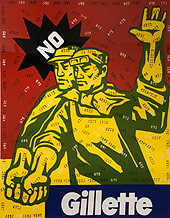
Wang Guangyi, No Gillette, Lithograph, 2002, 29 1/4 x 23 1/2 inches, Ed. 199 A number of works in the exhibition will be serigraphs. Serigraphs, the art of printing multiple images through screens originally made of silk, originated in China more than a thousand years ago. The technique became popular with artists throughout history due to its versatility. In recent years the market for limited-edition serigraphs by contemporary artists soared; in 2010 a serigraph by Andy Warhol sold for $63,362,500.Located at 169 Madeira Ave. in the heart of Coral Gables' business district, ArtSpace Virginia Miller Galleries is Greater Miami's longest-established contemporary fine art gallery, now in its 37th year. Highlights of the gallery's introduction of historically significant artists and art movements to this region and to the nation may be found at www.virginiamiller.com For more information, call 305-444-4493. Back to top^ FOCUS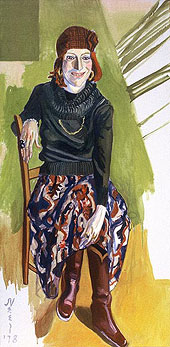
Alice Neel's 1978 portrait of Virginia Miller Virginia MillerGallery owner Virginia Miller is quoted in the new biography, "Alice Neel: The Art of Not Sitting Pretty," by Phoebe Hoban (St. Martin's Press, NY). In 1978 Miller gave Neel a retrospective of works on paper along with two oils, her recently completed full-length portrait of Miller and a 1958 head-and-shoulders portrait of John Rothschild, one of Neel's boyfriends. |
||||
|
|||||